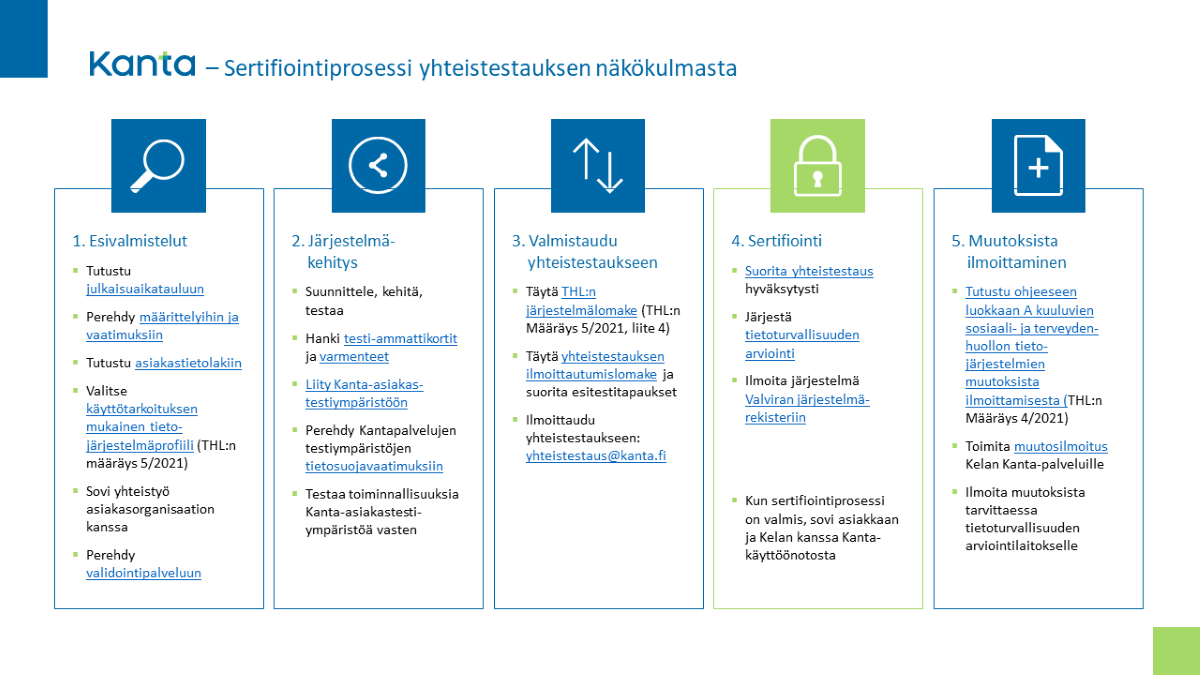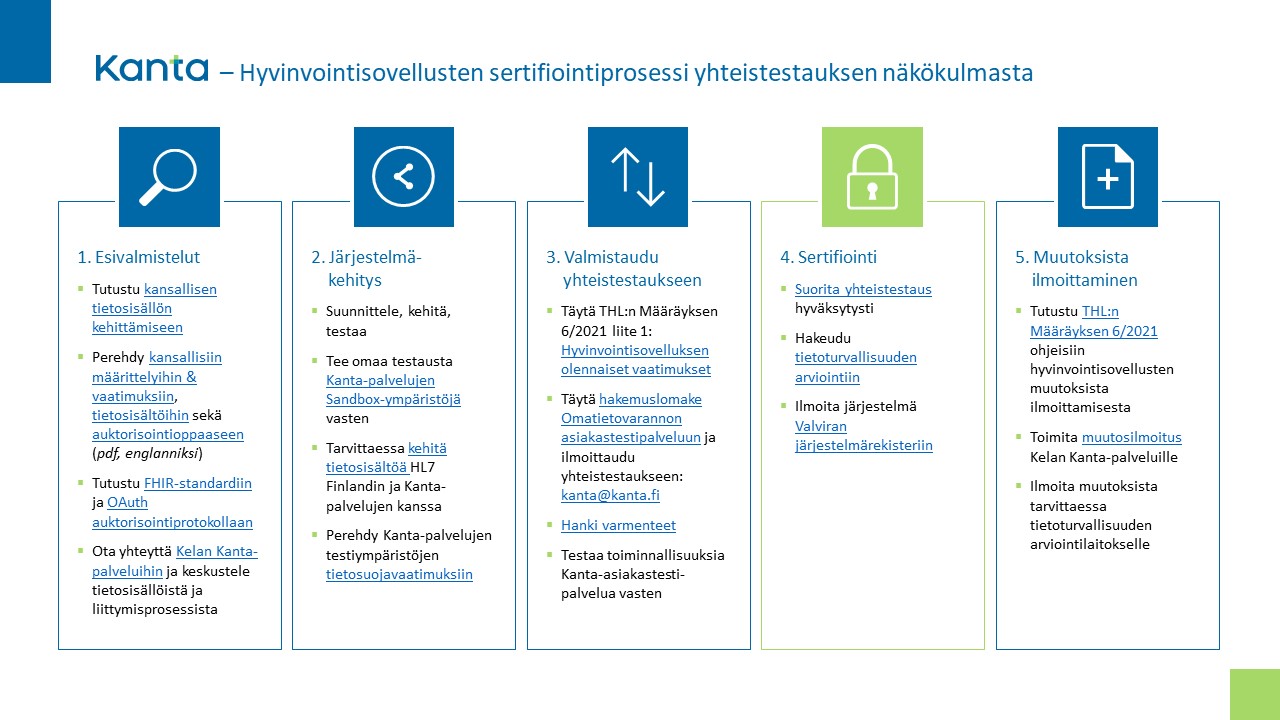The preparations include independent testing by the information system supplier in its own test environment and against the client test service. In joint testing, the preliminary test cases of the Kanta Services are carried out.
- Joint testing process for information system suppliers
- The joint testing process of Kanta PHR
- Instructions for joint testing aiming for first certification of a system
- Instructions for consequent joint testing of the system
- Performance of joint testing in practice
- Duration of joint testing
- Preconditions for starting joint testing by information system suppliers
Joint testing process for information system suppliers

The information system supplier registers for the joint testing in terms of each content to be tested. In connection with registration, the supplier must report pre-defined preliminary test cases, which are found on the registration form or sent from Kela on request. When the preliminary test cases have been successfully performed, Kela will hold a kick-off meeting with the supplier where the details related to joint testing are discussed. Depending on the contents to be tested, there are between one and three testing phases in joint testing. When all testing phases have been successfully passed, Kela will issue a joint testing statement and report for the information system. If any changes are made to the contents that have undergone joint testing, they must be notified to Kela on the notice of change.
The joint testing process of Kanta PHR

The wellbeing application supplier shall register for joint testing with respect to every data content to be tested. In connection with registering, the supplier shall deliver an application for the client test service of Kanta PHR and the completed document on THL’s key requirements. After registration, Kela will hold a kick-off meeting with the supplier where the details related to joint testing are discussed.
The testing phase between the application/system supplier and Kela is carried out in the joint testing of Kanta PHR. After the joint testing has been carried out and accepted, Kela will issue a joint testing statement and report for the wellbeing application. If any changes are later made to the contents that have undergone joint testing, they must be notified to Kela with the notice of change.
Instructions for joint testing aiming for first certification of a system
If an information system is certified for the first time, it must contact the Kanta Services after the start of the preparations phase according to the above process graphic. The message must be sent to the address kanta@kanta.fi. Based on the message, Kela will arrange a joint meeting with the information system supplier to discuss the development plans related to the system and the schedule for progress.
Before the start of joint testing, the system supplier must go through the system/system entity, which is to be certified, together with Kela and, if necessary, also with the other authorities taking part in the certification process, as well as the schedule of any joint testing. The discussion about the schedule must be held with the joint testing of the Kanta Services before the system is registered for joint testing. If necessary, other authorities taking part in the certification process shall also take part in the discussion.
When there is a joint plan for promoting joint testing, the system supplier can register their system for joint testing. THL’s system form describing the system architecture and the functions and data contents implemented in it shall be enclosed with the registration. In addition, an architecture description at the logical level must also be provided on the system. During registration, please note that the system form directs not only joint testing of the Kanta Services, but also the entire certification process, including the audit of information security and the registration notification to Valvira.
The system supplier is advised to reserve plenty of time for the certification process as a whole. Depending on the contents to be tested, there are between one and three testing phases in joint testing. When the system has successfully performed the joint testing, Kela will issue for the system a joint testing statement and report on passing the joint testing.
After joint testing, an information security assessment must be carried out on the system to be certified, and a certificate of information security assessment will be issued for the system after it has passed the assessment. The system can proceed to deployment after the certification process has been completed and the system has been registered and added to Valvira’s data systems register (valvira.fi, In Finnish).
System suppliers registering for joint testing should also become acquainted with the terms and definitions related to joint testing.
Instructions for consequent joint testing of the system
The manufacturer of the information system has the primary responsibility to ensure that the required changes are made in the system within schedule. This requirement is based on the Client Data Act, section 82 (finlex.fi, in Finnish) of which obliges that “the producer of an information system service must monitor changes in the key requirements of information systems and the wellbeing applications of the manufacturer of the wellbeing application and make the corrections required by the changes.” In addition, it is possible to make extensions to the functions and data contents of the system.
Joint testing is organised on the contents complying with the publication schedule, in which case the schedules for joint testing follow the schedule presented in the publication schedule. The joint testing need may also arise from legislative amendments and system changes carried out by the information system supplier or Kela. The schedules are also presented, for example, in supplier cooperation meetings aimed at the system suppliers. Further information about the contents of joint testing.
Registration for the next joint testing events for the system must be made by sending a completed joint testing registration form, the updated THL’s system form and the architecture description at the logical level to Kela’s joint testing by email to yhteistestaus@kanta.fi. Please submit the registration about two months before the preferred starting time for joint testing unless otherwise has been separately agreed with Kela.
Performance of joint testing in practice
Kela defines the test cases of joint testing, which the system supplier must perform during joint testing. The actual test cases of joint testing are delivered to the system supplier at the stage when it has successfully carried out the preliminary test cases that are required in connection with registration. The preliminary test cases can be viewed on the registration form for joint testing. The tabs General and System Data must also always be completed on the registration form.
Joint testing, including preliminary test cases, is documented on Kela’s Partners page in the system suppliers’ workspace. Kela will enter in the Partners workspace the test cases that must be performed with the system. The test cases are Excel files, which the system supplier can perform according to its own schedule. After the system supplier has performed the test cases, the reported Excel files must be returned to the Partners website and, at request, Kela shall be notified by email to yhteistestaus@kanta.fi. After that, Kela will add the returned test cases to the verification queue. The test cases are verified in the order of prioritisation and arrival.
If there are any issues or observations made with the test case, Kela’s joint testing will make a note of them in the Testing Situation and Verification Observations sections. Kela will also inform if the system supplier must perform the test case again after the correction of the observations. After the corrections have been made, the test cases to be retested must be returned to the Partners workspace for re-verification.
The joint testing situations are updated on the Kanta service-specific Situation of Joint Testing page.
After the system undergoing joint testing has successfully performed all the test cases allocated to it, Kela’s joint testing will issue a joint testing statement and report for the system.
Duration of joint testing
Every Kanta Service has its own joint testing content, for which more detailed specifications and timing will be planned separately. It is not possible to provide an accurate estimate of the duration of joint testing because the total duration of the testing phases depends, e.g. on
- the initial readiness of the information system
- the resources of the parties taking part in the testing
- the number of errors detected and the need to carry out retests
- the information contents to be tested.
It is possible to provide a case-specific estimate of the time schedule at the start of joint testing.
Preconditions for starting joint testing by information system suppliers
The information system supplier will assess when it is ready for starting the joint testing. The Kanta Services require that the information system supplier has carefully tested the information system to be connected to Kanta already before the start of joint testing. The production-like operation is verified in joint testing, and therefore the system must correspond to production-like implementation already at the start of joint testing. Any separate systems that may be connected to the main system must have been integrated when the system is submitted for joint testing.
To start joint testing, the information system must
- include the functionalities that meet the requirements for information systems to be connected to Kanta
- comply with the interfaces and standards of the national requirements
- be able to join the Kanta Services independently or with an integration solution independent of the supplier. The integration solution may have been arranged within the organisation or regionally.
Further requirements are that the information system supplier has
- tested all of the specified functionalities independently in the client test environments of the Kanta client test service while making sure that the information system meets the requirements in accordance with the specifications
- validated documents in the validation service
- provided Kela with the necessary information for the use of the Partners workspace (Register for joint testing)
- reported the preliminary test cases on the registration form to Kela and Kela has accepted their results
- delivered the THL system form to Kela
- when testing the system entities, delivered the architecture description of the entity to Kela
- assessed the extent of the necessary testing with the Kanta Services.
